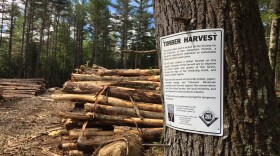"Forest succession" is a pattern of plant regeneration that begins when a plot of land is left to its own devices. The first phase of this succession is bare soil or an abandoned field. And nature, over the span of decades, converts the area through several stages to mature forest – if left undisturbed.
That bare lot, or abandoned field is first infiltrated by the grasses, weedy plants with small seeds delivered by the wind. These sun-loving species sprout and grow quickly, but are quickly shaded out by shrubby plants that are slower to grow but larger like goldenrods and small shrubs with woody stems.
Forest succession is an endurance race for time in the sun, and the shrubs in turn are also shaded out by the first trees to appear, including gray birch and aspen, along with a few white pines. Quick to grow, birch and aspen are also quick to fade when competition shades them out. White pine competes successfully by growing taller and straighter when hardwoods like maple, ash and oak join the competition.
That's forest succession, an important concept, in a very generalized nutshell.
Various natural disturbances like fire, wind and ice storms return succession to earlier stages. It's nature's way of fostering diversity as each stage supports a different mix of plants and animals. Without natural disturbances, mature forest would dominate, and the other successional stages would decline precipitously.








